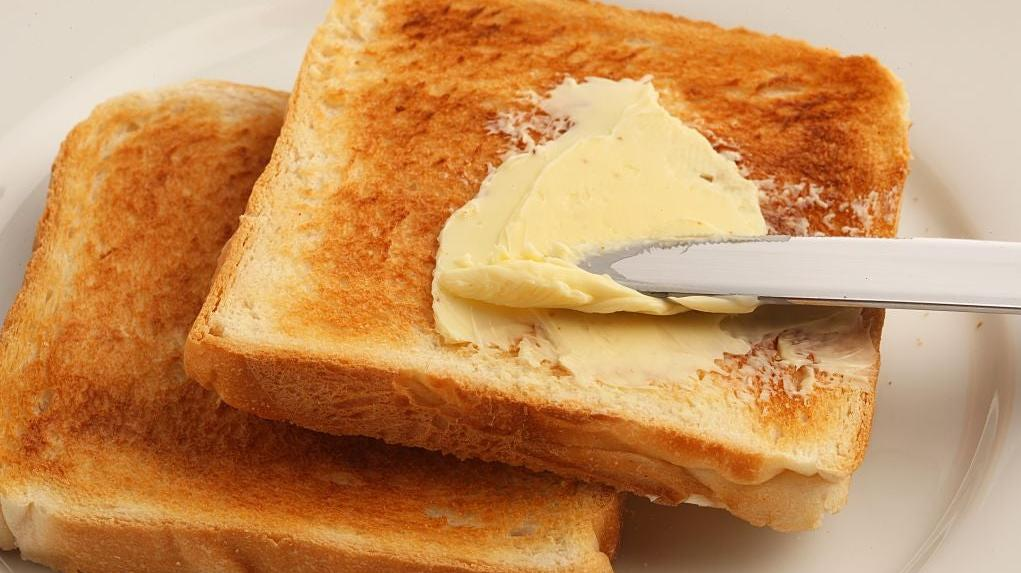What The Heck Kind Of Butter Should I Buy?
A few years back, our sister site Lifehacker published a treatise from Senior Food Editor Claire Lower that would change my life forever. The crux of the piece was that you should always keep two kinds of butter around: one for cooking and baking, and one for slathering and snacking. Since then, I've made it a habit to spring for fancy butter from my neighborhood Scandinavian bakery—excellent for toast—while keeping my fridge stocked with generic unsalted butter for baking purposes. It's the best of both worlds. Here's the problem: there are too many dang butter varieties out there. How's a layperson to know the best kind of butter for baking vs. cooking vs. snacking vs. searing and roasting? The following primer should help.
For your all-purpose butter needs: unsalted butter
This is an easy one. Sometimes called "sweet cream butter," unsalted butter is your best buddy if you want to play it safe. It's made from only milk and/or cream, and contains at least 80% milk fat as a rule. You'll find this guy next to the salted butter, which is butter that's been, ahem, salted for flavor. It's tough to know exactly how much salt is added to each brand, so I'd recommend erring on the side of caution and using unsalted butter when in doubt, especially if you're working with baked goods like brownies that don't require a ton of buttery flavor. Basically, unsalted or sweet cream butter will always do in a pinch—but if you want a very specific buttery flavor, please read on.
For bready baked goods: cultured butter
Cultured butter seems very fancy, but it's actually just a type of butter that's been treated with cultures (like yogurt). It's then allowed to ferment before being churned, resulting in a slightly tangy, very robust buttery flavor, Taste of Home explains. If you want to experiment with cultured butter, try using it in bready, hearty baked goods like biscuits, pound cakes, or even pancakes.
For fancy snacking and labor-intensive pastries: European-style butter
Like most European delights, European-style butter tastes more luxurious than its American counterpart. The difference comes down to butterfat, or the fatty part of milk. As The Washington Post explains, Europeans have higher standards for the minimum amount of butterfat in butter, requiring a minimum of 82% butterfat; in the U.S., the minimum requirement is 80%. More butterfat means a richer product, a softer texture, a faster melt, and sometimes a more vibrant yellow hue. All of that makes European-style butter the perfect candidate for your go-to Snacking/Slathering Butter. The Post notes that European-style butter is also a great option for intricate baked goods like croissants and pie dough, as the higher fat content can add to the baked good's overall flakiness.
Quick note: there's a difference between bona fide European butter and "European-style" butter. The former is manufactured in Europe; the latter is manufactured stateside according to European standards. If you find a brand you like, you'll be fine either way.
For searing and roasting: clarified butter
Time for a quick chemistry lesson. If you melt butter in a pan, you'll see a few things as it separates: milk solids, water, foam, and the bright yellow clarified butter fat. The term "clarified butter" refers strictly to the latter—pure fat strained out of milk solids and water. As you might imagine, clarified butter tastes much richer than traditional butter, with a toasty flavor and a high smoke point that, as Real Simple notes, makes it a great candidate for high-heat searing and roasting. One sticking point: you may have heard clarified butter referred to as "ghee," but the terms aren't interchangeable. Ghee is a popular type of clarified butter that originated in India thanks to its increased shelf stability. And while all ghee is clarified butter, but not all clarified butter is ghee. Happy slathering!
